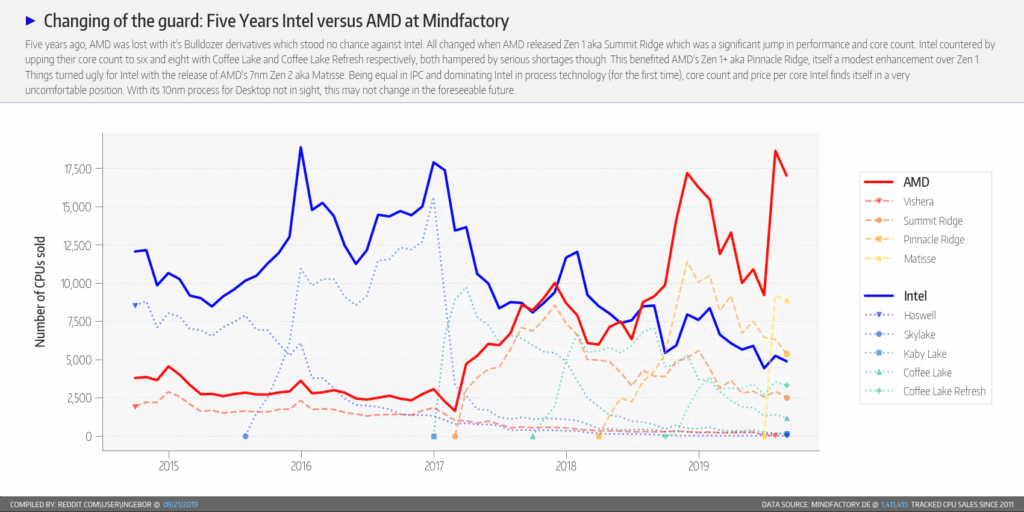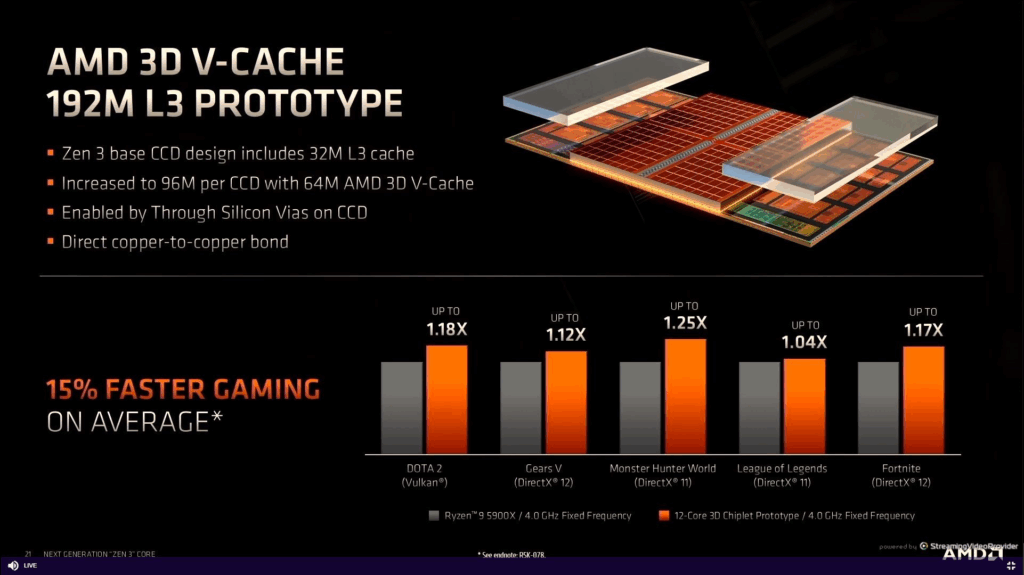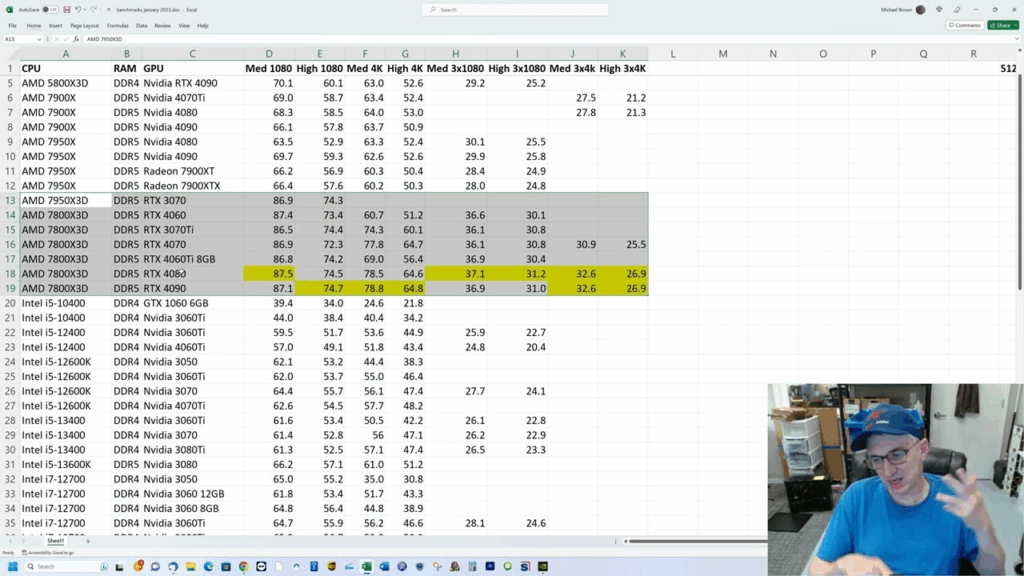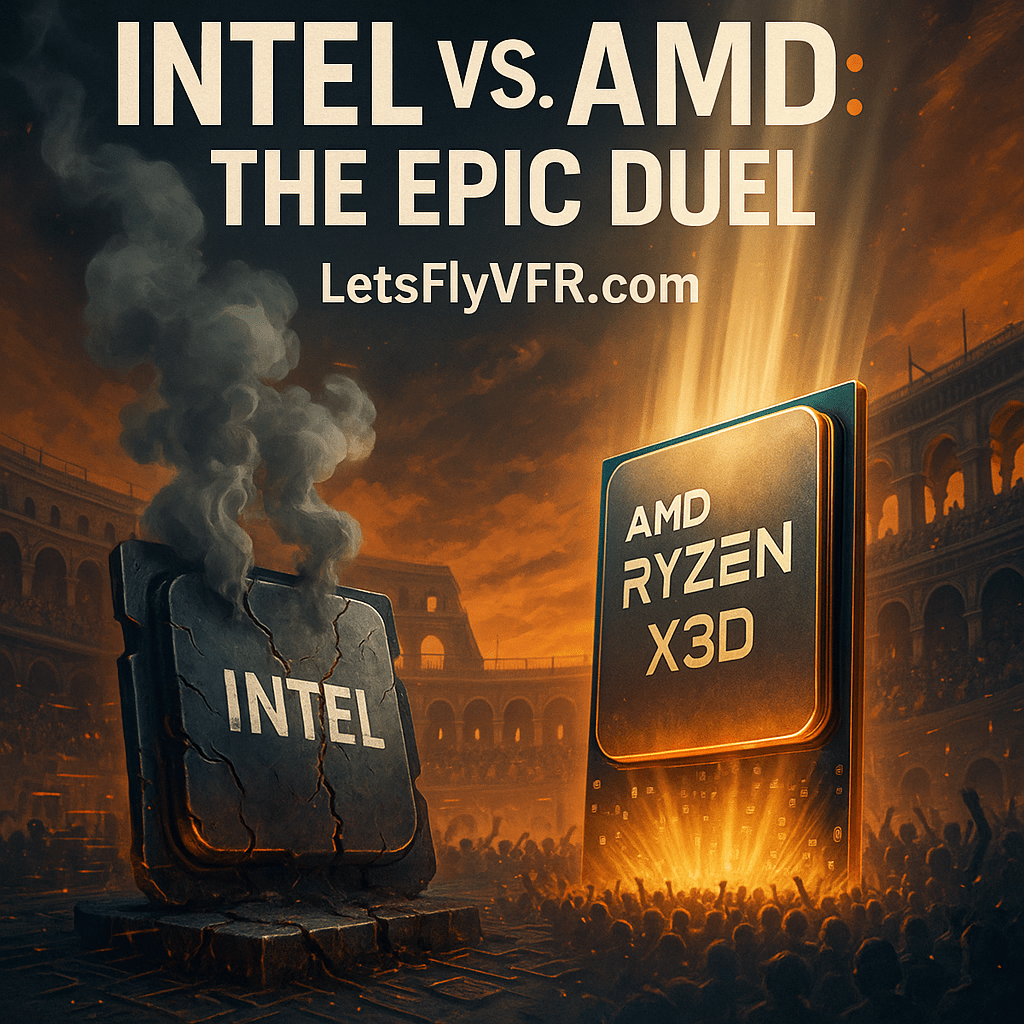AMD vs Intel: The Rise of Ryzen and the Complete AM4 CPU Guide for 2025
Introduction:
For decades the balance between AMD vs Intel was vast and Intel held the crown in the world of CPUs, dominating both gaming and productivity markets with little challenge. But in recent years, AMD has made a stunning comeback with its Ryzen series.
Thanks to smart design decisions, aggressive pricing, and innovation the battle of AMD vs Intel has changed with the introduction of 3D V-Cache, AMD’s Ryzen CPUs have become the top choice for gamers and content creators alike. We will look especially on the AM4 platform in this blog and cover the AM 5 platform very soon.
In this post, we’ll look at the history, the full AMD vs Intel history with the introduction of the AM4 product stack, performance comparisons, and help you choose the right CPU—whether you’re upgrading or building fresh. Its really exciting!
- Joystick / HOTAS – AMAZON.com
- Rudder Pedals – AMAZON.com
- Throttle Quadrant – AMAZON.com
- Gaming Chair – AMAZON.com
- VR Headset – AMAZON.com
A Brief History: Intel’s Reign and AMD’s Comeback
Intel led the CPU space through the 2000s and early 2010s, with its Core i-series offering unbeatable single-core performance. They delivered efficient thermal designs and widespread OEM adoption with unbeatable performance. AMD were relegated to the best of the rest and a long way behind in performance mostly.

AMD meanwhile with their FX-series chips just got overwhelmed and relegated surviving on lower prices to attract buyers predominantly. They were nearly written off by enthusiasts.
Everything changed in 2017 with the launch of Ryzen Processors and ZEN 1. These were built on AMD’s new Zen architecture. For the first time in years, AMD offered real competition, delivering more cores, threads, and price-to-performance value than Intel.
With Zen+, Zen 2, Zen 3, and now 3D V-Cache tech, AMD not only caught up—but in many workloads and games, it surged ahead.
The Full AMD AM4 CPU Product Stack
Let’s explore AMD’s entire AM4 Ryzen lineup from entry-level to high-end, including both standard and X3D models. These chips work with B450, B550, and X570 motherboards (check BIOS updates for compatibility).
🔹 1st Gen Ryzen (Zen – 2017)
Largely obsolete for new builds but worth noting historically.
- Ryzen 3 1200, Ryzen 5 1400/1500X/1600, Ryzen 7 1700/1700X/1800X
These new processors made INtel prick their ears and listen as AMD CPUs were fast and multicore now ready to complete with INTEL on a one on one basis. Not an immediate win but a very large step toward taking the market back.
🔹 2nd Gen Ryzen (Zen+ – 2018)
Still usable for light workloads and budget users.
- Ryzen 3 2200G, 2300X
- Ryzen 5 2400G, 2600, 2600X
- Ryzen 7 2700, 2700X
- Threadripper 2000 series (HEDT, not AM4)
I owned the 2600x and found it worked well with my GTX 1050 then RTX 2060 in flight sims like X Plane and DCS World. Now AMD were threatening INTELS dominance but the Intel fan base remained vocal on their dominance but it was slipping away and more and more new CPU buyers went to team RED!

🔹 3rd Gen Ryzen (Zen 2 – 2019–2020)
A big leap in IPC and efficiency. Still widely used.
- Ryzen 3 3100, 3300X
- Ryzen 5 3500, 3600, 3600X, 3600XT
- Ryzen 7 3700X, 3800X, 3800XT
- Ryzen 9 3900X, 3950X
- APUs: 3200G, 3400G (Zen+, not true Zen 2 cores)
The 3600x was also my next upgrade and proved to be quite good on the performance front. When the CPU’s are not priced sky high buyers like myself are willing to stretch and buy generation on generation and did so.
Intel memained defiant and still had an edge in performance at the top end but it was closing faster and faster as each generation was delivered by AMD.
🔹 4th Gen Ryzen (Zen 2 – 2020 OEM only)
- Ryzen 4000G Series (PRO 4350G, 4650G, 4750G) – not widely available for custom builds
🔹 5th Gen Ryzen (Zen 3 – 2020–2022)
Huge IPC jump, excellent for gaming and multitasking.
- Ryzen 5 5500, 5600, 5600X – AMAZON
- Ryzen 7 5700X, 5800X – AMAZON
- Ryzen 9 5900X, 5950X – AMAZON
- APUs: 4600G, 5600G – AMAZON
Personally chose again to follow AMD and upgrade to the AMD 5600X and this has stood the test of time now pushing FPS to the RTX 3070 in my own system. Intels chips started to have issues at about this point and AMD really took the lead in performance to price for sure in my opinion.
I have had the Ryzen 5 5600x for over 4 years and its only now its the X3D parts that there may be a reason to upgrade. Its a close call really with the variations in Benchmarks not always making the decision an easy clear cut decision.
Michael at X Force PC in the US made a video recently with an extensive breakdown of the performance of AMD 3D V cache / Non V Cache and Intel’s best CPUs and the benefits in flight simulation were proven beyond doubt! Ill Include that chart next and a link to the said video. If your not sure then this should help you make the best decision for your situation.

Zen 3 with 3D V-Cache (2022–2023)
Engineered specifically for gaming, these CPUs feature AMD’s groundbreaking 3D V-Cache technology, stacking additional L3 cache to dramatically improve performance in CPU-bound games.
Absolutely! Here’s the updated and improved Performance Tiers section with the Ryzen 7 5700X3D included as a midrange option, offering a clearer path for gamers and upgraders alike:
Performance Tiers: What to Choose Based on Your Budget
Here’s a simplified breakdown to help you pick the best AM4 CPU based on your budget, use case, and upgrade potential:
Budget Tier (Best Bang for Buck)
For value seekers and 1080p gamers upgrading from older Ryzen CPUs like the 2600 or 3600.
- Ryzen 5 2600 / 3600 – Still viable for entry-level gaming and multitasking.
- Upgrade Path:
- Ryzen 5 5500 – Affordable Zen 3 with better IPC, though limited to PCIe 3.0.
- Ryzen 5 5600 – Full PCIe 4.0 support, great gaming performance for under $150.
Midrange Tier (Sweet Spot for Most Users)
Perfect for gaming, streaming, and light productivity. Excellent balance of performance and price.
- Ryzen 5 5600X – A longtime favorite for its efficiency and strong gaming performance.
- Ryzen 7 5700X – Adds two more cores, ideal for multitasking or light creative workloads.
- 🔹 Ryzen 7 5700X3D – New in 2024, it combines 8-core power with 3D V-Cache for near-5800X3D gaming performance at a lower price—an incredible value in the midrange.
High-End Tier (Enthusiast Performance)
For those who want the absolute best in gaming or productivity on AM4.
- Ryzen 7 5800X3D – The definitive gaming CPU on AM4. Massive L3 cache = elite FPS.
- Ryzen 9 5900X / 5950X – Best for heavy workloads like 3D rendering, video editing, or serious multitasking.
Let me know if you’d like a visual tier chart or flowchart to pair with this breakdown!
3D V-Cache vs Standard Zen 3: Gaming vs Productivity

AMD’s 3D V-Cache technology stacks additional L3 cache on top of the CPU core die, increasing it to 96MB (vs 32MB in 5800X). This significantly reduces memory latency and improves frame rates in CPU-bound games—often outperforming even newer AM5 CPUs or Intel 13th/14th Gen chips.
However, the downside is that 5800X3D runs lower clock speeds, making it slightly worse for workloads like video encoding or 3D rendering compared to 5900X or 5950X.
Choose X3D if: Gaming is your top priority.
Choose non-X3D if: You do a lot of productivity or need all-core performance.
ALL AM-4 3D VCache CPU’s Available On Amazon – HERE
- Latest CPU’s Available Now – Amazon.com
- Get a NEW GPU Best Performance – AMAZON.com
- Upgrade RAM Here today – AMAZON.com
- Prebuilt PC Options – AMAZON.com
Final Thoughts: Should You Upgrade or Build New?
If you’re on an older AM4 chip like a Ryzen 5 2600 or 3600, or Ryzen 5 5600/5600X your ideal target should be around the Ryzen 5700X3D 5800X3D on your existing B450/B550 motherboard so you can unlock huge gains without the cost of a full platform change. It’s the best value upgrade path in PC gaming today.
But if you’re starting fresh and have the budget, waiting for an AM5 build may make more sense long-term—especially with DDR5, PCIe 5.0, and future-proofing.
NOTE: If your buying NEW then DON’t BUY AM4! It just makes sense to get straight to AM5 as you will get another 2 or 3 generational upgrades before the next platform arrives.
Next time, we’ll break down the AM5 Ryzen 7000/8000 CPUs and how they compare.
Quick Recap: Best AM4 CPUs by Category
- Budget Gaming: Ryzen 5 5500 or 5600 or 5600X3D (If you can find one)
- Midrange All-Rounder: Ryzen 5 5600X or Ryzen 7 5700X Ryzen 7 5700X3D
- High-End Gaming: Ryzen 7 5800X3D
- Productivity Beast: Ryzen 9 5900X or 5950X
Why 3D V-Cache Makes a Difference in Gaming

AMD’s 3D V-Cache technology stacks an extra layer of L3 cache directly on top of the CPU cores, massively increasing the total cache available — up to 96MB on chips like the RYZEN 5800X3D.
Ryzen 5700X3D – AMAZON / RYZEN 5800X3D CPU – AMAZON
This larger cache allows the CPU to keep more game data closer to the cores, reducing latency and avoiding costly trips to slower system memory. The result is a significant boost in gaming performance, especially in CPU-limited or competitive titles where frame rates matter most.
While non-X3D chips may have higher clock speeds, the extra cache on X3D models gives them a clear edge in real-world gaming scenarios.
Ryzen 5 5600X vs Ryzen 7 5800X3D: 1080p Gaming Performance
| Game Title | Ryzen 5 5600X Avg FPS | Ryzen 7 5800X3D Avg FPS | 1% Low (5600X) | 1% Low (5800X3D) |
|---|---|---|---|---|
| Shadow of the Tomb Raider | 156 | 169 | 102 | 129 |
| Hitman 3 | 162 | 170 | 127 | 137 |
| Red Dead Redemption 2 | 124 | 130 | 91 | 101 |
| Average Across 7 Games | 133.16 | 154.28 | 96.42 | 111.42 |
Source: Tech4Gamers
Key Takeaways:
- Performance Boost: The Ryzen 7 5800X3D offers approximately a 14.7% higher average FPS compared to the Ryzen 5 5600X across tested games.
- Smoother Gameplay: With higher 1% low FPS, the 5800X3D ensures more consistent frame rates, reducing stutters during gameplay.
- Gaming Optimization: The 5800X3D’s 3D V-Cache technology significantly enhances gaming performance, making it a top choice for gamers seeking the best experience on the AM4 platform.
Choosing the Right CPU for Your Needs:
- Budget-Conscious Gamers: If you’re upgrading from older CPUs like the Ryzen 5 2600 or 3600, the Ryzen 5 5600X provides excellent performance improvements without breaking the bank.
- Performance Enthusiasts: For those aiming for the highest FPS and smoother gameplay, especially in CPU-intensive games, the Ryzen 7 5800X3D is the superior choice.
- Productivity Users: While the 5800X3D excels in gaming, the Ryzen 9 5900X or 5950X might be better suited for tasks like video editing or 3D rendering due to their higher core and thread counts.
The Complete Beginner’s Guide to DCS World
Welcome to the world of Digital Combat Simulator (DCS World), the ultimate flight combat simulation that brings the thrill of…
Comparing Real World Aviation Procedures to Flight Sim Techniques.
Flight simulators have grown into sophisticated training tools, bridging the gap between virtual flight and real-world aviation….
Mastering Dogfighting in DCS World and Falcon BMS: Max-Perform Your
This post covers essential techniques, cues, and parameters that new combat pilots need to dominate close-range dogfights in DCS World…

Full Guide: DCS Balkans Map + All Upcoming DCS World
Full Guide: DCS Balkans Map + All Upcoming DCS World Modules. Summary: Eagle Dynamics and OnReTech have officially announced DCS: Balkans,…
DCS World T-45 Goshawk Formation Flying for Beginners Tutorial .
Military Formation Flying in DCS: Your First Flight in the T-45 Goshawk. So, you’ve got your wings (virtually speaking), strapped into…
DCS WORLD T-45 Goshawk EASY Navigation for Beginners.
DCS WORLD T-45 Goshawk EASY Navigation for Beginners is simply that. We do our planning in the DCS World Editor…
How the U.S. Navy Trains Jet Pilots: A Complete T-45
Welcome to Letsflyvfr.com guide to T-45C Goshawk Training – How the U.S. Navy Trains Jet Pilots so you can train…
DCS WORLD – The MB-339 by IndiaFoxtEcho: A Complete Overview.
The MB-339 occupies a very particular niche in DCS World: it’s not a fighter, not a frontline attack jet, but…
How to Move DCS World to Another Drive – Tutorial.
Moving DCS World off your Windows drive is a great way to free up space especially with DCS now taking…
Author

Brendon McAliece (Aka Gunnie) is a military veteran with 23 years working on Jet Fighters, their weapons systems and ejection seat/module systems as well as munitions and R&D. Involved with flight simulation since the 1980s, he has flown all the major flight simulators over the years.
He is an Australian expat who has lived in Malaysia, UK, Saudi Arabia and more recently Thailand. He is a multi-lingual blogger who loves to share his life experiences here on LetsFlyVFR.com and DreamingGuitar.com, with his lifestyle and Travel experiences Blog plus his Dreaming Coffee website.
Learn More @
DreamingGuitar.com – DreamingCoffee.com – LetsFlyVFR.com
( HOME – BLOG – SHOP – ABOUT )
As an Amazon affiliate I may benefit from qualifying sales.









One response to “AMD vs Intel: The Rise of Ryzen and the Complete AM4 CPU Guide for 2025”